Chapter 4: Managing Firm Resources
Intellectual Property
Learning Objectives
- Define the four major types of intellectual property.
- Be able to provide examples of each intellectual property type.
- Understand how intellectual property can be a valuable resource for firms.
Defining Intellectual Property
The inability of competitors to imitate a strategic resource is a key to leveraging the resource to achieve long–term competitive advantages. Companies are clever, and effective imitation is often very possible. But resources that involve intellectual property reduce or even eliminate this risk. As a result, developing intellectual property is important to many organizations.
Intellectual property is the legal rights that result from intellectual activity in the industrial, scientific, literary, and artistic fields (Canadian Intellectual Property Office, 2014).
The four main types of intellectual property are patents, trademarks, copyrights, and trade secrets (Figure 4.8 “Types of Intellectual Property”). If a piece of intellectual property is valuable, rare, and nonsubstitutable, it can also constitute a strategic resource. Even if a piece of intellectual property does not meet all four criteria as a strategic resource, it can be bundled with other resources and activities to create a strategic-level resource.
A variety of formal and informal methods are available to protect a firm’s intellectual property from imitation by rivals. Some forms of intellectual property are best protected by legal means, while defending others depends on surrounding them in secrecy. For example, KFC’s secret blend of eleven herbs and spices is famous for being a trade secret. This can be contrasted with WestJet Airlines’ well-known culture, which rivals are free to attempt to copy if they wish. WestJet’s culture thus is not intellectual property, although some of its complements such as WestJet’s logo and unique colour schemes are.
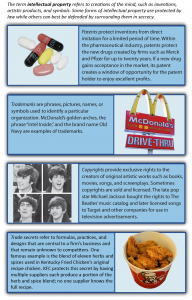
Patents
Patents are legal decrees that protect inventions from direct imitation for a limited period of time (Figure 4.9 “Patents”). In Canada, a patent is a right, granted by government, to exclude others from making, using, or selling your invention for twenty years after the patent application is filed. Obtaining a patent involves navigating a challenging process. To earn a patent from the Canadian Intellectual Property Office, there are three basic criteria for patentability:
- The invention must show novelty (be the first in the world).
- It must show utility (be functional and operative).
- It must show inventive ingenuity and not be obvious to someone skilled in that area.
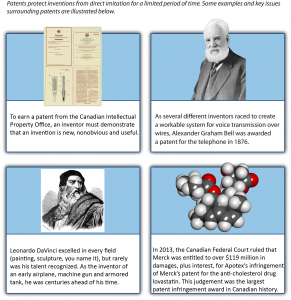
A patent is granted only for the physical embodiment of an idea (for example, the description of a door lock) or for a process that produces something tangible or can be sold. You cannot patent a scientific principle, an abstract theorem, an idea, some methods of doing business, or a computer program per se. Once an invention is patented in Canada, exclusive rights are granted to the patent holder as defined in the Patent Act (Government of Canada, 1985). Any interference with the patent holder’s “full enjoyment of the monopoly granted by the patent” is considered a patent infringement (CanLII, 2004).
You may obtain a patent for an improvement to an existing invention, but keep in mind that the original patent may still be in force. If this is the case, manufacturing or marketing the product with your improvement would probably be an infringement. This situation is often resolved by agreement between the patentees to grant licences to each other.
In 1986, Windsurfing International Inc. v. Trilantic Corp. dealt with a manufacturer selling the unassembled components of a patented sailboard (1986). In the court’s decision, it was stated:
Without assembly there can be no purpose in a purchaser buying the unassembled parts since, unassembled, they cannot be used for the purpose for which they are purchased, that is, to sail. To suggest that a patent infringement suit can be successfully avoided by selling parts as components of a kit in contradistinction to their sale assembled is, in my view, errant nonsense.
–Windsurfing International Inc. v. Trilantic Corp. (1986), 8 C.P.R. (3d) 241
One alternative is to maintain the innovation as a trade secret. This can be very cost-effective protection and, unlike a patent, can last indefinitely. However, once the secret is out, the protection is completely lost. As well, trade-secret protection gives you no rights against third parties who independently discover the same invention and patent it.
Patenting an invention is important because patents can protect and generate enormous profits. Imagine, for example, the potential for lost profits if the Slinky had not been patented. Shipyard engineer Richard James came up with the idea for the Slinky by accident in 1943 while he was trying to create springs for use in ship instruments. When James accidentally tipped over one of his springs, he noticed that it moved downhill in a captivating way. James spent his free time perfecting the Slinky and then applied for a patent in 1946. As noted above, in 1966 the patent expired, and anyone can now use this invention. To date, more than 300 million Slinkys have been sold by the company that Richard James and his wife Betty created.

Trademarks
Trademarks are a word (or words), a design, or a combination of these used to identify the goods or services of one person or organization (Figure 4.11 “Trademarks”). Trademarks are important because they help an organization stand out and build an identity in the marketplace. Some trademarks are so iconic that almost all consumers recognize them, including McDonald’s golden arches, the Nike swoosh, and Apple’s outline of an apple.
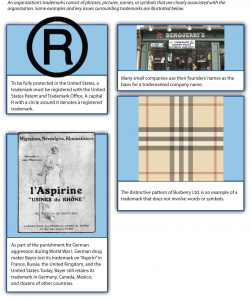
Other trademarks help rising companies carve out a unique niche for themselves. For example, French shoe designer Christian Louboutin has trademarked the signature red sole of his designer shoes. Because these shoes sell for many hundreds of dollars at upscale retailers, competitors would love to copy that look. Thus, legally protecting the distinctive red sole from imitation helps preserve Louboutin’s profits. It should be noted that although the average consumer might not be able to identify the specific shade of red that was granted a trademark, a similar, but different, red colour used in shoe soles was deemed not to be a trademark infringement.
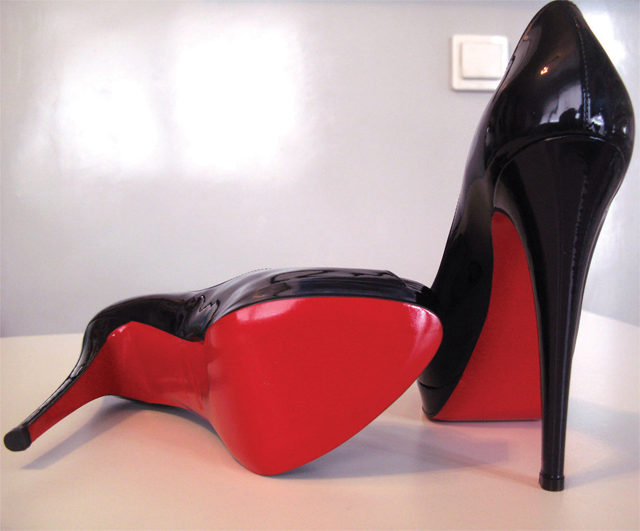
Trademarks are important to colleges and universities. Schools earn tremendous sums of money through royalties on T-shirts, sweatshirts, hats, backpacks, and other consumer goods sporting their names and logos. On any given day, there are probably several students in your class wearing one or more pieces of clothing featuring your school’s insignia; your school benefits every time items like this are sold.
Schools’ trademarks are easy to counterfeit, however, and the sales of counterfeit goods take money away from colleges and universities. Counterfeit products are often inferior in quality and may even pose a potential health or safety hazard to the consumer. Not surprisingly, many schools and other entities fight to protect their trademarks, including educating consumers. The Vancouver Canucks website (and those of many other national sports teams) features a section called “Fight the Fake” that includes tips on ways to spot counterfeit products in order to promote the authorized version and protect one of its sources of revenue (NHL.com, 2014).
Copyrights
Copyrights provide exclusive rights to the creators of original artistic works such as books, movies, songs, and screenplays (Figure 4.13 “Copyrights”). Unlike patents that are only enforceable for 20 years, copyright exists for the duration of author’s lifetime plus an additional 50 years.
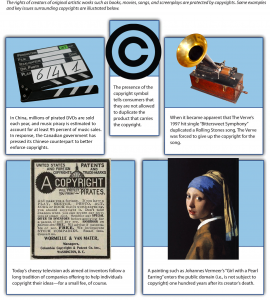
Sometimes copyrights are sold and licensed. In the late 1960s, Buick thought it had an agreement in place to license the number one hit “Light My Fire” for a television advertisement from The Doors until the band’s volatile lead singer Jim Morrison loudly protested what he saw as mistreating a work of art. Classic rock by The Beatles has been used in television ads in recent years. After the late pop star Michael Jackson bought the rights to the band’s music catalog, he licensed songs to Target and other companies. Some devoted music fans consider such ads to be abominations, perhaps proving the merit of Morrison’s protest decades ago.
Over time, piracy has become a huge issue for the owners of copyrighted works. In China, millions of pirated DVDs are sold each year, and music piracy is estimated to account for at least 95 percent of music sales. This piracy deprives movie studios, record labels, and artists of millions of dollars in potential royalties. In response to the damage piracy has caused, the Canadian and U.S. governments have pressed their Chinese counterpart and other national governments to better enforce copyrights.
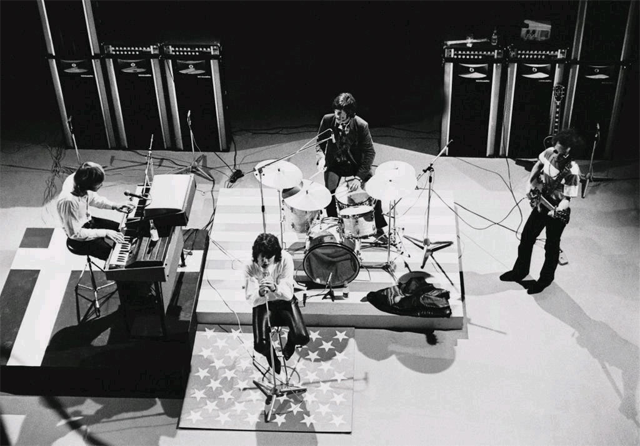
Trade Secrets
The definition of a trade secret can vary from one jurisdiction to another. In general, it is information that provides a business advantage over a competitor and is subject to reasonable efforts to maintain its secrecy. Trade secrets can be formulas, practices, designs, patterns, data compilations, devices or instruments, processes, etc. Sometimes a trade secret can be protected contractually through certain legal concepts and statutes.
Trade secrets cover a very wide variety of items, contained or embodied in, but not limited to, a formula, pattern, plan, compilation, computer program, method, technique, process, product, device or mechanism; it may be information of any sort; an idea of a scientific nature, or of a literary nature. Trade secrets grant an economical advantage to the business and improve its value (Turner, 1962). Additionally, there must be some element of secrecy. Matters of public knowledge or of general knowledge in an industry cannot be the subject matter of a trade secret (Vaver, 1981) (Figure 4.15 “Trade Secrets”).
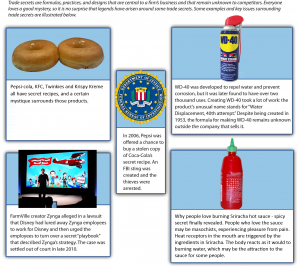
Some trade secrets have become legendary, perhaps because a mystique arises around the unknown. One famous example is the secret blend of eleven herbs and spices used in KFC’s original recipe chicken. KFC protects this secret by having multiple suppliers each produce a portion of the herb and spice blend; no one supplier knows the full recipe. Similarly, Coca-Cola’s flavor mix is also shrouded in mystery. In 2006, Pepsi was approached by shady individuals who were offering a chance to buy a stolen copy of Coca-Cola’s secret recipe. Pepsi wisely refused. An FBI sting was used to bring the thieves to justice. The soft-drink industry has other secrets too. Dr Pepper’s recipe remains unknown outside the company. Although Coke’s formula has been the subject of greater speculation, Dr Pepper is actually the original secret soft drink; it was created a year before Coca-Cola.
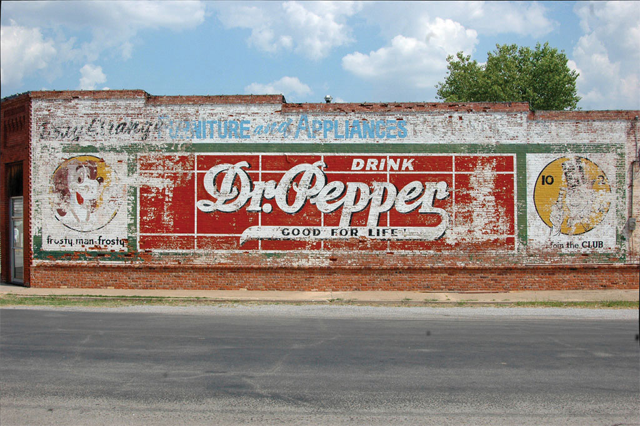
Key Takeaways
- Intellectual property can serve as a strategic resource for organizations. While some sources of intellectual property such as patents, trademarks, and copyrights can receive special legal protection, trade secrets provide competitive advantages by simply staying hidden from competitors.
Exercises
- What designs for your college or university are protected by trademarks?
- What type of intellectual property provides the most protection for firms?
- Why would a firm protect a resource through trade secret rather than by a formal patent?
References
Cameron, Donald M. (1977). Windsurfing International Inc. v. Trilantic Corp. (1986), 8 C.P.R. (3d) 241. Retrieved from http://www.jurisdiction.com/windsuca.htm
Canadian Intellectual Property Office. (2014). What Is Intellectual Property? Retrieved from http://www.cipo.ic.gc.ca/eic/site/cipointernet-internetopic.nsf/eng/Home
CanLII. (2004). Monsanto Canada Inc. v. Schmeiser, 2004 SCC 34, [2004] 1 SCR 902. Retrieved from http://www.canlii.org/en/ca/scc/doc/2004/2004scc34/2004scc34.html
Government of Canada. (1985). Patent Act. Retrieved from http://laws-lois.justice.gc.ca/eng/acts/P-4/section-42.html
NHL.com. (2014). Vancouver Canucks. Fight the Fake. Retrieved from http://canucks.nhl.com/club/page.htm?id=66864
Turner, A. (1962). The Law of Trade Secrets. London: Sweet & Maxwell
Vaver, D. (1981). Civil Liability for Taking or Using Trade Secrets in Canada. The Canadian Business Law Journal.
Ward, C. (2009, October 8). OU works to prevent trademark infringement. The Oklahoma Daily. Retrieved from http://www.oudaily.com/news/2009/oct/08/ou-works-prevent-trademark-infringement
Image description
Figure 4.8 image description: Types of Intellectual Property
The term intellectual property refers to creations of the mind, such as inventions, artistic products, and symbols. Some forms of intellectual property are protected by law while others can best be defended by surrounding them in secrecy.
- Patents protect inventions from direct imitation for a limited period of time. Within the pharmaceutical industry, patent protect the new drugs created by firms such as Merck and Pfizer for up to twenty years. If a new drug gains acceptance in the market, its patent creates a window of opportunity for the patent holder to enjoy excellent profits.
- Trademarks are phrases, pictures, names, or symbols used to identify a particular organization. McDonald’s golden arches, the phrase “Intel Inside,” and the brand name Old Navy are examples of trademarks.
- Copyrights provide exclusive right to the creators of original artistic works such as books, movies, songs, and screenplays. Sometimes copyrights are sold and licenced. The late pop star Michael Jackson bought the rights to The Beatles’ music catalog and later licensed songs to Target and other companies for use in television advertisements.
- Trade secrets refer to formulas, practices, and designs that are central to a firm’s business and that remain unknown to competitors. One famous example is the blend of eleven herbs and spices used in KFC’s original recipe chicken. KFC protects this secret by having multiple suppliers each produce a portion of the herb and spice blend; no one supplier knows the full recipe.
Figure 4.9 image description: Patents
Patents protect inventions from direct imitation for a limited period of time. Some examples and key issues surrounding patents are illustrated below.
- To earn a patent from the Canadian Intellectual Property Office, an inventor must demonstrate that an invention is new, nonobvious, and useful.
- As several different inventors raced to create a workable system for voice transmission over wires, Alexander Graham Bell was awarded a patent for the telephone in 1876.
- Leonardo DaVinci excelled in every field (painting, sculpture, you name it), but rarely was his talent recognized. As the inventor of an early airplane, machine gun, and armored tank, he was centuries ahead Of his time.
- In 2013, the Canadian Federal Court ruled that Merck was entitled to over $119 million in damages, plus interest, for Apotex’s infringement of Merck’s patent for the anti-cholesterol drug lovastatin. This judgement was the largest patent infringement award in Canadian history.
Figure 4.11 image description: Trademarks
An organization’s trademarks consist of phrases, pictures, names, or symbols that are closely associated with the organization. Some examples and key issues surrounding trademarks are illustrated below.
- To be fully protected in the United States, a trademark must be registered with the United States Patent and Trademark Office. A capital R with a circle around it denotes a registered
trademark. - Many small companies use their founders’ names as the basis for a trademarked company name, such as Ben and Jerry’s.
- As part of the punishment for German aggression during World War l, German drug maker Bayer lost its trademark on “Aspirin” in France, Russia, the United Kingdom, and the United States. Today, Bayer still retains its trademark in Germany, Canada, Mexico, and dozens of other countries.
- The distinctive pattern of Burberry Ltd. is an example of a trademark that does not involve words or symbols.
Figure 4.13 image description: Copyrights
The rights of creators of original artistic works such as books, movies, songs, and screenplays are protected by copyrights. Some examples and key issues surrounding copyrights are illustrated below.
- In China, millions of pirated DVDs are sold each year, and music piracy is estimated to account for at least 95 percent of music sales. In response, the Canadian government has pressed its Chinese counterpart to better enforce copyrights.
- The presence of the copyright symbol tells consumers thatthey are not allowed to duplicate the product that carries
the copyright. - When it became apparent that The Verve’s 1997 hit single “Bittersweet Symphony” duplicated a Rolling Stones song, The Verve was forced to give up the copyright for the song.
- Today’s cheesy television ads aimed at inventors follow a long tradition of companies offering to help individuals copyright their ideas—for a small fee, of course.
- A painting such as Johannes Vermeer’s “Girl with a Pearl Earring” enters the public domain (ie., is not subject to copyright) one hundred years after its creator’s death,
Figure 4.15 image description: Trade Secrets
Trade secrets are formulas, practices, and designs that are central to a firm’s business, and remain unknown to competitors. Everyone loves a good mystery, so it is no surprise that legends have arisen around some trade secrets. Some examples and key issues surrounding trade secrets are illustrated below.
- Pepsi-Cola, KFC, Twinkies, and Krispy Kreme all have secret recipes, and a certain mystique surrounds those products.
- In 2006, Pepsi was offered a chance to buy a stolen copy of Coca-Cola’s secret recipe. An FBI sting was created and the thieves were arrested.
- WD 40 was developed to repel water and prevent corrosion, but it was later found to have over two thousand uses. Creating WD—40 took a lot of work: the product’s unusual name stands for “Water Displacement, 40th attempt.” Despite being created in 1953, the formula for making WD—IO remains unknown outside the company that sells it.
- FarmVille creator Zynga alleged in a lawsuit that Disney had lured away Zynga employees to work for Disney and then urged the employees to tum owr a secret “playbook” that described Zynga•s strategy. The case was settled out of court in late 2010
- The spicy secret of why people love burning Sriracha hot sauce was finally revealed. people Who love the sauce may be masochists, experiencing pleasure from pain. Heat receptors in the mouth are triggered by the ingredients in Sriracha. The body reacts as it would to burning water, which may be the attraction to the sauce for some people.
Media Attributions
- Figure 4.8: Attribution information for all included images is in the chapter conclusion.
- Figure 4.9: Attribution information for all included images is in the chapter conclusion.
- 2006-02-04 Metal spiral © Roger McLassus is licensed under a CC BY-SA (Attribution ShareAlike) license
- Figure 4.11: Attribution information for all included images is in the chapter conclusion.
- Louboutin altadama140 © Arroser is licensed under a CC BY-SA (Attribution ShareAlike) license
- Figure 4.13: Attribution information for all included images is in the chapter conclusion.
- The Doors in Copenhagen 1968 © Polfoto/Jan Persson is licensed under a Public Domain license
- Figure 4.15: Attribution information for all included images is in the chapter conclusion.
- Dr. Pepper Sign © anyjazz65
The legal rights that result from intellectual activity in the industrial, scientific, literary, and artistic fields (Canadian Intellectual Property Office, 2014).
Legal decree that protects inventions from direct imitation for a limited period of time.
A word (or words), a design, or a combination of these used to identify the goods or services of one person or organization.
Provides exclusive rights to the creators of original artistic works such as books, movies, songs, and screenplays.
Theft of trademark or copyrighted material.

